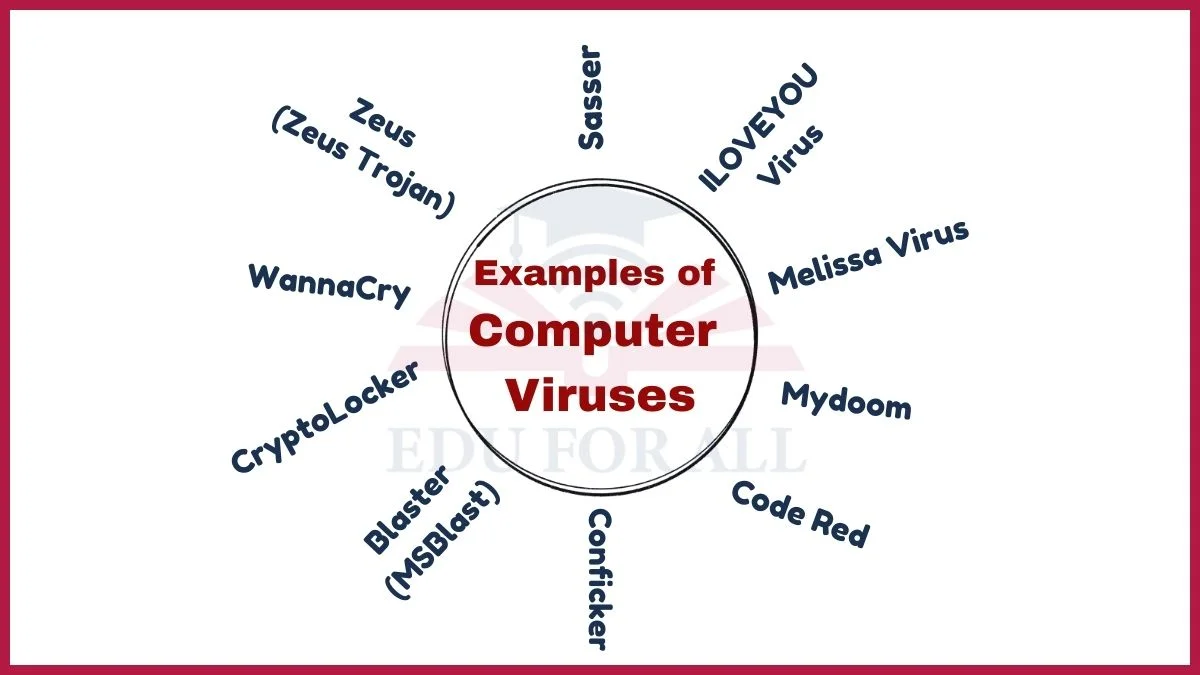A computer virus is a type of malicious software program that spreads by inserting copies of itself into other programs or files. Viruses can self-replicate, damage hardware, software, or data, and interfere with computer operation.
ILOVEYOU Virus, Melissa Virus, Mydoom, Code Red, Blaster (MSBlast), Conficker, and Sasser are the most common examples of computer viruses.
Examples of Computer Viruses
Here are some common examples of computer viruses:

1. ILOVEYOU Virus
The ILOVEYOU virus spread through emails. It was one of the first major phishing attacks. This virus tricked people with a fake love letter. It caused a lot of damage in 2000 by making computers lose important information and money.
ILOVEYOU costs about $15 billion in damages around the world.
2. Melissa Virus
Melissa was a macro virus that targeted Microsoft Word documents. It spreads through email attachments. It replicated itself by sending infected documents to the first 50 contacts in the victim’s address book.
Melissa became one of the fastest-spreading viruses in history within a few days.
3. Mydoom
Mydoom is a worm that spreads through emails. This virus attacked specific websites. It also opened a secret door, letting hackers control infected computers for planned attacks.
Mydoom caused about $38 billion in damages.
4. Code Red
Code Red was a worm that took advantage of problems in Microsoft Internet Information Services (IIS). It changed websites to say “Hacked by Chinese!” and made a group of infected servers.
Code Red infected over 359,000 computers in less than 14 hours.
5. Slammer (SQL Slammer)
Slammer used a problem in Microsoft SQL Server. It spreads very fast. It causes big problems on the internet in just a few minutes and stops important services.
The Slammer doubled its size about every 8.5 seconds.
6. Blaster (MSBlast)
Blaster took advantage of a problem in Windows. It made infected computers restart over and over and tried to stop people from updating their Windows.
Blaster infected over 8 million computers within two weeks.
7. Conficker
Conficker spread through problems in computer networks. This virus makes a big group of infected computers. It was hard to stop and stayed a danger for a long time.
Conficker infected millions of computers and stayed a problem for years.
8. Sasser
Sasser used a problem in Windows LSASS (Local Security Authority Subsystem Service). It causes infected systems to reboot continuously. It moved through the internet without needing people to do anything.
Sasser infected hundreds of thousands of computers very quickly.
9. CryptoLocker
CryptoLocker was a virus that locked up files on people’s computers. It asked for money to unlock them. It shows how some viruses want to get money from people.
CryptoLocker took millions of dollars from its victims.
10. WannaCry
WannaCry took advantage of a problem in Windows and spread fast through networks. It asked for money in Bitcoin. It causing problems for organizations worldwide, like the NHS in the UK.
WannaCry infected over 200,000 computers in 150 countries.
11. Nimda
Nimda, which spells “admin” backward. It was a virus that spread through emails, computer networks, and websites. It caused big problems by attacking many things at once.
Nimda infected millions of computers in just a few hours.
12. Zeus (Zeus Trojan)
Zeus was a trick that stole important information, like passwords and bank details. It made a big group of infected computers to do financial crimes.
Zeus caused a lot of financial losses around the world.
13. Stuxnet
Stuxnet was a very smart worm that aimed to break Iran’s nuclear program. It was a big deal because it showed that countries could use viruses in wars.
Stuxnet was made by the U.S. and Israeli governments together.
14. Storm Worm
Storm Worm was a trick sent through emails. It made a big group of infected computers for many bad things, including sending spam and launching DDoS attacks.
Storm Worm controlled millions of infected computers.
15. Sobig.F
Sobig.F spread through emails, causing a lot of problems. It took email addresses from infected computers to spread even more.
Sobig.F infected millions of computers within days.
16. Bagle
Bagle was a family of worms that spread through email attachments. It established a backdoor on infected systems. It allows remote control and facilitates additional malware downloads.
Bagle had many different types and lasted for many years.
17. Mimikatz
Mimikatz was a tool that stole passwords from Windows. It was a big danger because it could get important information.
Mimikatz became a tool of choice for many cyber criminals.
18. Netsky
Netsky was a family of viruses spread through email. It often looked like an antivirus update, fooling people into opening the bad part.
Netsky viruses took over a lot of email traffic when they were active.
19. IcedID
IcedID is a virus that steals bank information. It usually targets online banking. This virus is a big risk to people’s money and personal details.
Fact: IcedID is hard to find and stop because it uses advanced tricks.
20. Mirai Botnet
Mirai targeted Internet of Things (IoT) devices. It creates a powerful botnet for launching distributed denial-of-service attacks. It caused major disruptions in 2016.
Infected hundreds of thousands of devices.

